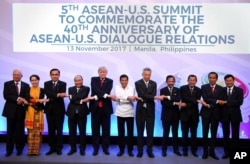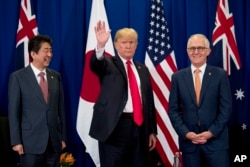A bloc of four powerful, Western-allied nations, intent on keeping the South China Sea open for international use despite growing Chinese control, will probably issue stern statements, help China’s maritime rivals and hold joint naval exercises near the contested waterway this year, analysts say.
Australia, India, Japan and the United States, a group known as the quad, are most likely to take those measures rather than directly challenging Chinese claims such as its military installations among the sea’s 500 small islets.
“Number one, presence is probably going be driven by the U.S.,” said Stuart Orr, professor of strategic management at Deakin University in Australia. “If I were to take a guess, I would say probably follow that by India, with Japan taking a little bit more of the same role as Australia does, at providing high-level logistical support.”
The quad countries want to keep the 3.5 million-square-kilometer, resource-rich sea open while protecting their own economic ties with Beijing, say experts who follow the issue. Multiple countries ship, fish and explore for oil in the South China Sea today.
Cautionary pronouncements
Heads of state from the four-way alliance met in Manila in November to discuss keeping the sea open. Australia and Japan separately called then for “rules-based order” and “respect for international law” in the sea.
Indian Prime Minister Narendra Modi told leaders from 10 Southeast Asian countries, including four that compete with China for maritime sovereignty, January 26 that India was committed to working together more on maritime matters.
Expect more statements designed to keep China on guard, analysts say.
“I think the most concrete thing they can do is to issue some statements on the South China Sea dispute, and even then I believe that China might not even be explicitly named in such a statement,” said Ben Ho, senior analyst with the Military Studies Programme at the S. Rajaratnam School of International Studies in Singapore.
China calls about 90 percent of the sea its own. Chinese expansion since 2010 has irritated rival claimants Brunei, Malaysia, the Philippines, Taiwan and Vietnam. Those governments, all militarily weaker than Beijing, bristle when China fortifies disputed islets for military use and passes coast guard ships through contested waters.
Beijing says historical records prove its claim to the sea, an argument rejected in 2016 by a world arbitration court.
Joint military exercises
Combinations of the four countries might pass naval vessels through the South China Sea, especially along its perimeters or the coastal waters of smaller countries that want help resisting Chinese vessels, experts say.
The United States, the world's top military power, has sent naval vessels to the South China Sea five times under President Donald Trump, extending a practice under his predecessor to assert Washington’s view that the sea should allow freedom of navigation.
Japan may follow as it tries to “break out of its self-imposed restraints,” said Oh Ei Sun, international studies instructor at Singapore Nanyang University.
Tokyo passed a helicopter carrier through the disputed sea in June 2017. Japan vies with China over tracts of the East China Sea, as well. Leaders are in Tokyo are studying constitutional changes to give the armed forces more power.
“You will see Japan trying to make more frequent port calls and indeed join military exercises, providing training and so on to these nations,” Oh said.
India and Australia would support any military movement aimed at warning China, analysts say. Australia could become a place to monitor “what’s going on” and become a platform for any follow-up, Orr said.
India will make port calls and join any naval patrols with other countries, said Sameer Lalwani, deputy director for U.S. think tank The Stimson Center’s South Asia program. India vies with China for geopolitical control in south and central Asia.
“India could also enhance the number of military exercises, both national and joint with other countries to improve proficiency, enhance cooperation, and signal capabilities,” Lalwani said. “Obviously more visible cooperation with the United States would send an even stronger message.”
Arms supplies
Japan will “continue to bolster the capacities” of allied Asian countries, said Stephen Nagy, senior associate professor in politics and international studies at International Christian University in Tokyo.
Expect military training, new equipment and two naval destroyer visits this year to Vietnam “as a message that their relations are deepening,” he said.
Vietnam has been the most aggressive South China Sea claimant aside from China. In January 2017 Japanese Prime Minister Shinzo Abe pledged to provide six patrol boats for Vietnam's coast guard. The U.S. government is also planning to let one of its aircraft carriers visit the Southeast Asian country this year.
“With the U.S. sending ships as well, Vietnam and other countries are being courted for more security partnerships,” Nagy said.
India has previously helped Vietnam explore the sea for oil. It may look to the quad for chances to grow its economy, technology and foreign relations, experts believe.
Chinese reaction
China is expected to react to the quad one act at a time. If they make statements, China will use words in return, Ho said. If the other countries hold military exercises, China might double down on fortifying the islets it holds now in the Paracel and Spratly chains.
India and Japan are unlikely to push too hard overall as they grapple with their own disputes involving China, Ho said. India and China contest two tracts of their mountainous land border.
China’s chief deterrent for the quad players may be its economic might. Australia, for example, counts China as its No. 1 trade partner, with a 27 percent increase in exports in 2016 and 2017, official Australian data show. A naval drill is unlikely, Ho said.
“I think Canberra has too much at stake in terms of economic links with Beijing to take such a drastic measure,” he said. “After all China is Australia’s top trading partner, both in terms of imports and exports, and Canberra will not do anything drastic to damage its relationship.”











